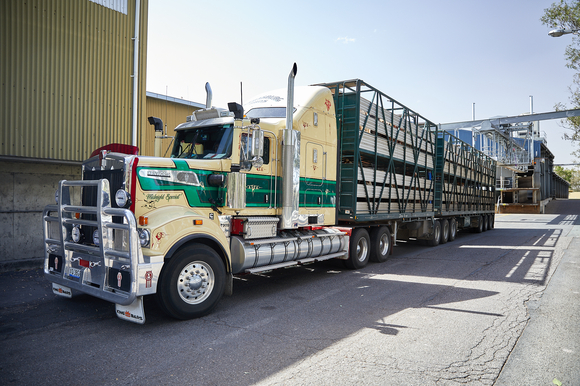How effective effluent capture can help to maximise carcase weight
15 August 2022
Key points:
- Managing cattle’s feed intake in the final 12 hours prior to dispatch has the potential to maximise carcase weight when combined with appropriate effluent capture systems.
- A trial has shown that domestic trade heifers with access to full feed at the time of feedlot exit had hot carcase weights that were 1.2, 1.1, or 1.8kg heavier than cattle withheld from feed for 4, 8, or 12 hours, respectively.
- Effluent captured in tanks could be used for direct land application contingent on environmental licensing, land availability and infrastructure development for irrigation.

Managing cattle’s feed intake in the final 12 hours prior to dispatch from feedlots has the potential to maximise carcase weight when combined with effluent capture in truck tanks and disposal at approved discharge points, a recent MLA-funded study has found.
This project aimed to give lot feeders, transporters, processers and regulatory authorities objective data to make informed decisions regarding best management of effluent produced by feedlot cattle during transportation.
Truck effluent from feedlot cattle consists of manure, urine, potential bedding materials, and water collected within livestock transport vehicles. It is considered a by-product of the beef industry and must be well-managed to minimise its effect on the environment.
One of the possible management techniques is the capture of effluent in truck tanks and trailers with disposal at approved discharge points. Withdrawing feed may also be a possible management strategy for truck effluent; however, no research has occurred locally to determine the effects of this practice in feedlot cattle.
Study design
Drs Matthew and Melissa George provided scientific guidance to ensure the project was designed, executed and analysed to yield clear results for industry. The project also involved collaboration with University of Queensland environmental engineers to determine effluent use cases.
The study compared four durations of feed withdrawal including 0, 4, 8, and 12 hours on truck effluent volume and composition, carcase characteristics, and microbiological contamination of feedlot cattle. Specifically, this project was completed in four blocks per season (16 blocks total) and included a total of 64 pens including 4,943 domestic heifers. Cattle were loaded at a feedlot near Roma, Queensland and transported to Brisbane for a total transit length of 545km. Effluent volume and composition were measured at Dalby and Brisbane. The project also explored the most cost-effective means of effluent disposal and use.
Results:
- Reduced duration of feed withdrawal increased hot carcase weight and liver glycogen levels without impacting meat quality.
- Compared to 0h of feed withdrawal, hot carcase weight decreased for cattle withheld from feed for 4, 8 and 12h by 1.2, 1.1 and 1.8kg, respectively.
- Of total effluent captured in tanks and trailers, approximately two-thirds was produced during the first half of the journey. Overall, there was no difference in effluent captured in tanks for the total journey for different feed withdrawal treatments.
- Loss from animals (cutaneous and respiratory evaporation) and truck (evaporation, convection, spillage) was impacted by duration of feed withdrawal, however the difference was small over the 545km haul (0 vs 12h, 68.2kg per truck).
- There was no statistical difference between 0 and 4 hours of feed withdrawal for loss.
Analysis of best effluent disposal methods
A variety of uses for the feedlot effluent from this project were explored including municipal sewer disposal, standalone or red meat processor biogas facilities and direct land application.
Sewer disposal was not found to be viable as it exceeds sewer acceptance criteria for solids, nitrogen and phosphorus and is prohibitively costly. Incorporating effluent into standalone or red meat processor biogas facilities was also found to be undesirable due to its negative value proposition. Despite early indications that it may be suitable for energy recovery using anaerobic digestion, the nitrogen and ammonia inhibition could present a challenge that would limit the success of biogas technologies.
Finally, direct land application of effluent was seen as most favourable, contingent on environmental licensing, land availability and infrastructure development for irrigation.


